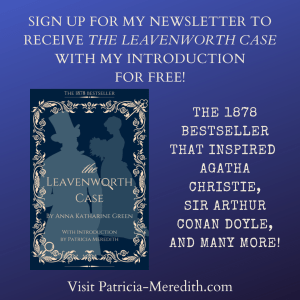Reading: The Clocks by Agatha Christie
I love to re-read Agatha Christie mysteries. There are so many wonderful ones, and if I wait long enough, I sometimes forget exactly how the mystery works itself out. 😉
The reason I made a point of re-reading this particular one, however, was because it is in this book that Agatha Christie gives a decided nod to Anna Katharine Green. The Leavenworth Case, itself, is mentioned by Poirot:
“The Leavenworth Case…is admirable… One savers its atmosphere, its studied and deliberate melodrama. Those rich and lavish descriptions of the golden beauty of Eleanor, the moonlight beauty of Mary!… and there is the maidservant, Hannah, so true to type, and the murderer, an excellent psychological study.”
This is not the only reference to Anna Katharine Green in this book, however. Whether Christie meant to or not, she also referenced her works in the title image. The Clocks mystery begins when a dead man is found in a blind woman’s home by a typist requested to come at a specific time and to let herself in. Mysterious extra clocks are found in the front room with the body, and make me wonder if Christie had the idea for at least part of the story after reading Anna Katharine Green’s short story “The House of Clocks” (published in 1915), in which her girl detective Violet Strange is drawn into a mystery involving a house with a large collection of clocks.
As Agatha Christie herself writes in this book:
“One gets infected, it is true, by a style of a work one has been reading.”This is one of the reasons why I’m very particular about what I’m reading while I’m working on a book. For example, when writing my Anna Katharine Green mystery, I only read and listened to her works, specifically The Leavenworth Case, of course, but also her poems and other work. When I’m not writing, I have more freedom in what I choose to read, though lately I’ve been limiting myself to mysteries and 19th century literature to keep my mind in that time frame and style.
The Clocks is really one of my favorite Hercule Poirot mysteries and he’s barely in it. He gives a marvelous diatribe about crime fiction through which Christie voices her opinion of other writers, as well as herself in the guise of Ariadne Oliver, the character pretty openly based on herself. In addition to Anna Katharine Green, several other infamous authors are mentioned, including, of course, Sir Arthur Conan Doyle’s creation. I found it intriguing that Christie does not point to Sherlock Holmes, however, but to his sidekick:
“It is the author, Sir Arthur Conan Doyle, that I salute. These tales of Sherlock Holmes are in reality farfetched, full of fallacies and most artificially contrived. But the art of the writing—ah, that is entirely different. The pleasure of the language, the creation above all of that magnificent character, Dr. Watson. Ah, that was indeed a triumph.”
Indeed, although the sidekick character had been done before—in fact by Anna Katharine Green among others—Sherlock’s creation of Watson most certainly impacted the creation of Hastings for Poirot.
Poor Hastings. Poirot has been left behind by his trusted counterpart in this story. As he says, “What an absurdity to go and bury oneself in South America, where they are always having revolutions.” Ha! What a Poirot thing to say.
Another of my favorite quotes from the book is related to a bookshop described thusly:
“It was clear that the books owned the shop rather than the other way about. Everywhere they had run wild and taken possession of their habitat, breeding and multiplying and clearly lacking any strong hand to keep them down.”
This is how I always dreamed my house would look when I grew up! Mountains of books piled here and there.
And I just love the reference to Alfred Hitchcock’s Rear Window!! The movie was made in 1954, so as The Clocks was published in 1963, Hitchcock came first in this case. Though it should also be noted that the movie was based on the short story “It Had to Be Murder” by Cornell Woolrich, published in 1942. In the case of The Clocks, there is a little girl who is laid up with a broken leg and spends time using binoculars (“opera glasses”) to look out the window and record what she sees in her little notebook. What she sees becomes pivotal to the final twist.
I promise all my reviews won’t be Agatha Christie novels, but I just had to make special mention of this one since it crosses the streams with all the research I’ve been doing lately into Anna Katharine Green. And really, in the end, can any mystery reader NOT include Agatha Christie in his or her repertoire?
Thanks for reading!
